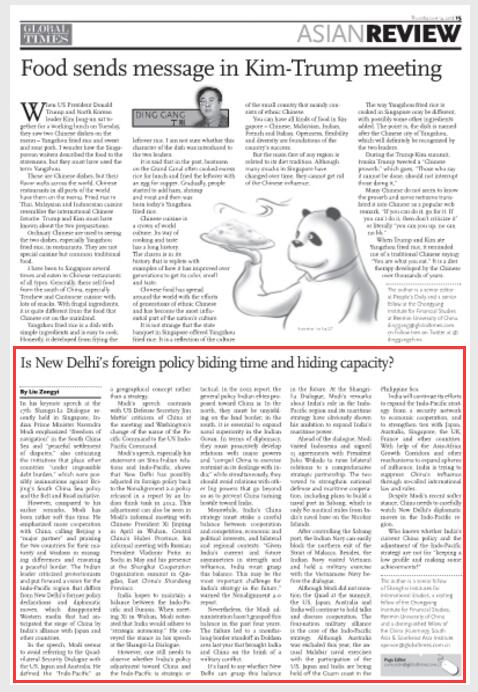Major Power Relations
Your Present Location: PROGRAMS> Major Power RelationsLiu Zongyi: Is New Delhi’s foreign policy biding time and hiding capacity?
By Liu Zongyi Source: Global Times Published: 2018-6-13
In his keynote speech at the 17th Shangri-La Dialogue recently held in Singapore, Indian Prime Minister Narendra Modi emphasized "freedom of navigation" in the South China Sea and "peaceful settlement of disputes," also criticizing the initiatives that place other countries "under impossible debt burden," which were possibly insinuations against Beijing`s South China Sea policy and the Belt and Road initiative.

However, compared to his earlier remarks, Modi has been rather soft this time. He emphasized more cooperation with China, calling Beijing a "major partner" and praising the two countries for their maturity and wisdom in managing differences and ensuring a peaceful border. The Indian leader criticized protectionism and put forward a vision for the Indo-Pacific region that differs from New Delhi`s former policy declarations and diplomatic moves, which disappointed Western media that had anticipated the siege of China by India`s alliance with Japan and other countries.
In the speech, Modi seems to avoid referring to the Quadrilateral Security Dialogue with the US, Japan and Australia. He defined the "Indo-Pacific" as a geographical concept rather than a strategy.
Modi`s speech contrasts with US Defense Secretary Jim Mattis` criticism of China at the meeting and Washington`s change of the name of the Pacific Command to the US Indo-Pacific Command.
Modi`s speech, especially his statement on Sino-Indian relations and Indo-Pacific, shows that New Delhi has possibly adjusted its foreign policy back to the Nonalignment 2.0 policy released in a report by an Indian think tank in 2012. This adjustment can also be seen in Modi`s informal meeting with Chinese President Xi Jinping in April in Wuhan, Central China`s Hubei Province, his informal meeting with Russian President Vladimir Putin in Sochi in May and his presence at the Shanghai Cooperation Organization summit in Qingdao, East China`s Shandong Province.
India hopes to maintain a balance between the Indo-Pacific and Eurasia. When meeting Xi in Wuhan, Modi reiterated that India would adhere to "strategic autonomy." He conveyed the stance in his speech at the Shangri-La Dialogue.
However, one still needs to observe whether India`s policy adjustment toward China and the Indo-Pacific is strategic or tactical. In the 2012 report, the general policy Indian elites proposed toward China is: In the north, they must be unyielding on the land border; in the south, it is essential to expand naval superiority in the Indian Ocean. In terms of diplomacy, they must proactively develop relations with major powers and "compel China to exercise restraint in its dealings with India;" while simultaneously, they should avoid relations with other big powers that go beyond so as to prevent China turning hostile toward India.
Meanwhile, India`s China strategy must strike a careful balance between cooperation and competition, economic and political interests, and bilateral and regional contexts. "Given India`s current and future asymmetries in strength and influence, India must grasp this balance. This may be the most important challenge for India`s strategy in the future," warned the Nonalignment 2.0 report.
Nevertheless, the Modi administration hasn`t grasped this balance in the past four years. The failure led to a months-long border standoff in Doklam area last year that brought India and China on the brink of a military conflict.
It`s hard to say whether New Delhi can grasp this balance in the future. At the Shangri-La Dialogue, Modi`s remarks about India`s role in the Indo-Pacific region and its maritime strategy have obviously shown his ambition to expand India`s maritime power.
Ahead of the dialogue, Modi visited Indonesia and signed 15 agreements with President Joko Widodo to raise bilateral relations to a comprehensive strategic partnership. The two vowed to strengthen national defense and maritime cooperation, including plans to build a naval port in Sabang, which is only 80 nautical miles from India`s naval base on the Nicobar Islands.
After controlling the Sabang port, the Indian Navy can easily block the northern exit of the Strait of Malacca. Besides, the Indian Navy visited Vietnam and held a military exercise with the Vietnamese Navy before the dialogue.
Although Modi did not mention the Quad at the summit, the US, Japan, Australia and India will continue to hold talks and discuss cooperation. The four-nation military alliance is the core of the Indo-Pacific strategy. Although Australia was excluded this year, the annual Malabar naval exercises with the participation of the US, Japan and India are being held off the Guam coast in the Philippine Sea.
India will continue its efforts to expand the Indo-Pacific strategy from a security network to economic cooperation, and to strengthen ties with Japan, Australia, Singapore, the UK, France and other countries. With help of the Asia-Africa Growth Corridors and other mechanisms to expand spheres of influence, India is trying to suppress China`s influence through so-called international law and rules.
Despite Modi`s recent softer stance, China needs to carefully watch New Delhi`s diplomatic moves in the Indo-Pacific region.
Who knows whether India`s current China policy and the adjustment of the Indo-Pacific strategy are not for "keeping a low profile and making some achievements?"
The author is a visiting fellow of the Chongyang Institute for Financial Studies, Renmin University of China.
Key Words: India; China; South China Sea; Liu Zongyi























































































 京公网安备 11010802037854号
京公网安备 11010802037854号





